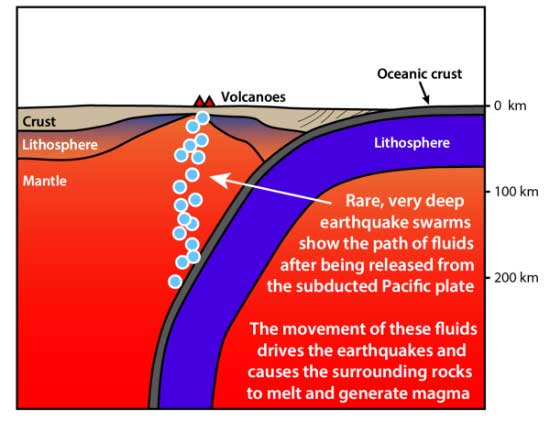Most of the world’s explosive volcanoes are located in volcanic arcs, framed by liquid fluxed melting of upper mantle rocks. The fluids that facilitate melting are discharged from subducted tectonic plates as they sink into the mantle.
Scientists have sparse knowledge of the migration pathways of melts through the upper mantle. They are also uncertain of the time required for this migration to occur.
In a new study, scientists found that deep under the sea bed, a sinking tectonic plate causes a “swarm” of the earthquake, feeding the molten rock into newly forming volcanoes.
Earthquake swarms are events where a local area experiences numerous quakes striking in a moderately brief timeframe. Scientists showed the evidence of two earthquake swarms that occur in the upper mantle beneath the Mariana and Izu-Bonin arc systems in the Pacific Ocean.
For the detailed study, scientists created a 3D map and plotted each earthquake swarm on it. They found that the sequences of earthquakes form a pipe-like structure through which molten rock flows. It then rises from a sinking tectonic plate at depths of around 200km to a magma chamber underneath a volcano.
Scientists noted that the discovery helps them solve a missing piece of the tectonic puzzle. They also uncovered the path from where fluids and molten rock move to volcanoes at the surface.
The IBM arc system extends over 2800 km south from Tokyo, Japan, to beyond Guam, and includes the Izu Islands, Bonin Islands, and the Mariana Islands; much more of the IBM arc system is submerged below sea level. It marks where two tectonic plates – the Philippine Sea Plate and the Pacific Plate – meet.
As the Pacific Plate subducts, sinking into the Earth’s mantle, it carries water deep down into the Earth. The plate gets hotter and experiences more pressure, the deeper it goes. Till then the superheated water attempts to evade, making the stone break and melt and making a pathway for the molten rock to rise.
Lead author Dr. Lloyd White from UOW’s School of Earth, Atmospheric and Life Sciences described the process as a natural hydro-fracking effect.
“In fracking used by the petroleum industry, they drill into the Earth up to a few kilometers deep, and then continue to pump liquid down until the pressure grows, and the rocks crack, creating a path for the petroleum or natural gas to flow through the rocks and into a pipe back to the surface.”
“In this case, the tectonic plate carries the water down very deep into the Earth, down to around 200 kilometers below the surface. As the plate goes down, it gets hotter, and the pressure gets higher, driving water out of the subducted plate.”
“It’s ultimately the water that causes those slowly moving rocks to melt as well as to cause these rare earthquakes. The water gets so hot and is under so much pressure that it needs to get away. As it moves upwards, it causes the rocks to fracture and melt, forming magma, and that magma is what feeds to the volcano at the top of the system.”
“It is similar to fracking, but at a much grander scale and completely driven by Earth’s natural processes, rather than being human-induced.”
Dr. White said, “The two earthquake swarms occurred deep in the Earth in a zone that doesn’t usually have any earthquakes. The simplest explanation is they were caused by a process similar to fracking, either by the rock breaking ahead of the superheated fluid or by the pipe collapsing after the fluid had moved through the system.”
“Geologists have always assumed that the water in this system goes upwards, but we’ve never had a good way of imaging that. These examples – a freak occurrence that we’ve stumbled on – show very clearly where the water must be traveling.”
Co-author Dr. Dominique Tanner, also from UOW’s School of Earth, Atmospheric and Life Sciences, said: “We can use the earthquakes to figure out how quickly these fluids travel. We know exactly when and where the earthquakes occur, so we can estimate how quickly the fluid moves through the deep Earth, which is faster than one kilometer an hour – much faster than we previously thought.”
Scientists expected that more research might help scientists monitor which volcanoes are being primed with increasing amounts of magma from the deep Earth.
The international team included scientists from the University of Wollongong (UOW), Royal Holloway University of London, University of Cambridge, Australian National University, Columbia University, Cardiff University, and Durham University.

